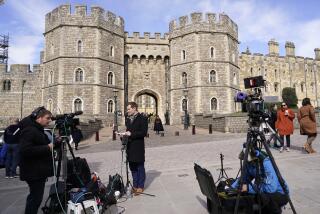British royal baby part of an approaching sea change in Britain
- Share via
LONDON — As a jubilant Britain wonders what the future will bring for its newest heir to the throne, who went home with his parents to start his royal life Tuesday, there’s one thing the littlest prince seems set to bring to Britain’s future: a paradigm shift.
For more than 60 years, this country has been ruled by a female monarch, who was crowned when Britain was still recovering from World War II. Most of Queen Elizabeth II’s subjects today have known no other head of state and find her a symbol of national stability.
But the birth of a son to Prince William and his wife, Catherine, means that, once Elizabeth goes, Britain could well have men on the throne into the 22nd century. (The baby born Monday would be 87 then, the same age his reigning great-grandmother is now.) Britons accustomed to singing “God Save the Queen” are going to have to get used to new lyrics.
Though few people paused in their celebrations Tuesday to ponder what difference it might make to have monarchs who can grow beards, royal historian Robert Lacey said there could be a jarring change in style — and not necessarily a welcome one.
As a figurehead, the British monarch no longer fulfills traditionally masculine functions such as leading the nation into battle, Lacey noted. William currently serves in the military, as his father once did, though neither in a senior position. Having a woman on the throne can seem better suited to a more peaceable age, someone who is more of a conciliator, not a conqueror.
“Modern societies respond better to a mother of the country than a father of the country,” Lacey said. “The essence of the British monarchy is that the monarch has no executive power. Therefore the caring, motherly functions become more important.”
Partly owing to her longevity, Elizabeth has been a reassuring constant in British life through times of political and social upheaval. She routinely tops the polls as the most popular and respected member of the royal household. Between them, Elizabeth and Britain’s other long-serving queen, her great-great-grandmother Victoria, have reigned for 125 of the last 176 years.
The current heir apparent is Prince Charles, 64, followed by William, 31. Third in line is William’s newborn child, He Who Has Not Been Named. (As it happens, the fourth and fifth in line are males as well: Prince Harry, William’s younger brother, and then Prince Andrew, Charles’ brother.)
The three direct heirs were together for the first time during a visit by Charles to his grandson late Tuesday afternoon, in the exclusive Lindo Wing of St. Mary’s Hospital in central London. Enthusiastic royalists got their first glimpse of the highly anticipated baby shortly thereafter, when William and Catherine, Duchess of Cambridge emerged with their son in her arms to a storm of camera flashes.
It was the shot seen round the world, an Instagrammed tableau of royal domestic bliss on the same steps where William himself made his public debut as an infant in the embrace of his parents, Prince Charles and the late Princess Diana, in 1982. Many of the photographers who clamored for the shot had camped outside the hospital for days, in some cases weeks.
“He’s got a good pair of lungs on him, that’s for sure,” William said, cradling his son. “He’s a big boy, quite heavy.”
The consuming question of the baby’s name — or, more likely, string of names — was left unanswered, though odds makers favor such not-so-imaginative royal names as George and James.
“We’re still working on a name. We’ll have that as soon as we can,” the prince said.
Britain continued to herald the new heir with the pomp and pageantry it has perfected over the centuries. At the same time Tuesday afternoon, imperiling the hearing of thousands of Londoners, a 41-gun salute went off in Green Park, next to Buckingham Palace; a 62-gun salute began at the Tower of London; and a peal of bells rang out at Westminster Abbey that lasted three hours.
William and his family will live in Kensington Palace, the royal lodging in West London that had been occupied by his mother. Expected to be a hands-on dad, the prince has exhibited a softer side that Lacey said could mesh well with the image of the monarchy as a more feminine institution under his grandmother. Charles, too, has his sensitive side and his interests in environmental protection and architectural preservation.
And anyway, royal fans will always have the kings’ consorts to obsess over, even if the women don’t actually sit on the throne. Catherine is probably more of a focus of international attention than her husband-who-would-be-king.
“People like women. They like the glamour,” said Carolyn Bartlett, 65, who works with a hospital charity. “A king has to be a decent, intelligent man, also good with people and a friend of the armed forces and well-educated. But his wife is much more in the media and public eye.”
News assistant Janet Stobart of The Times’ London bureau contributed to this report.
More to Read
Sign up for Essential California
The most important California stories and recommendations in your inbox every morning.
You may occasionally receive promotional content from the Los Angeles Times.














